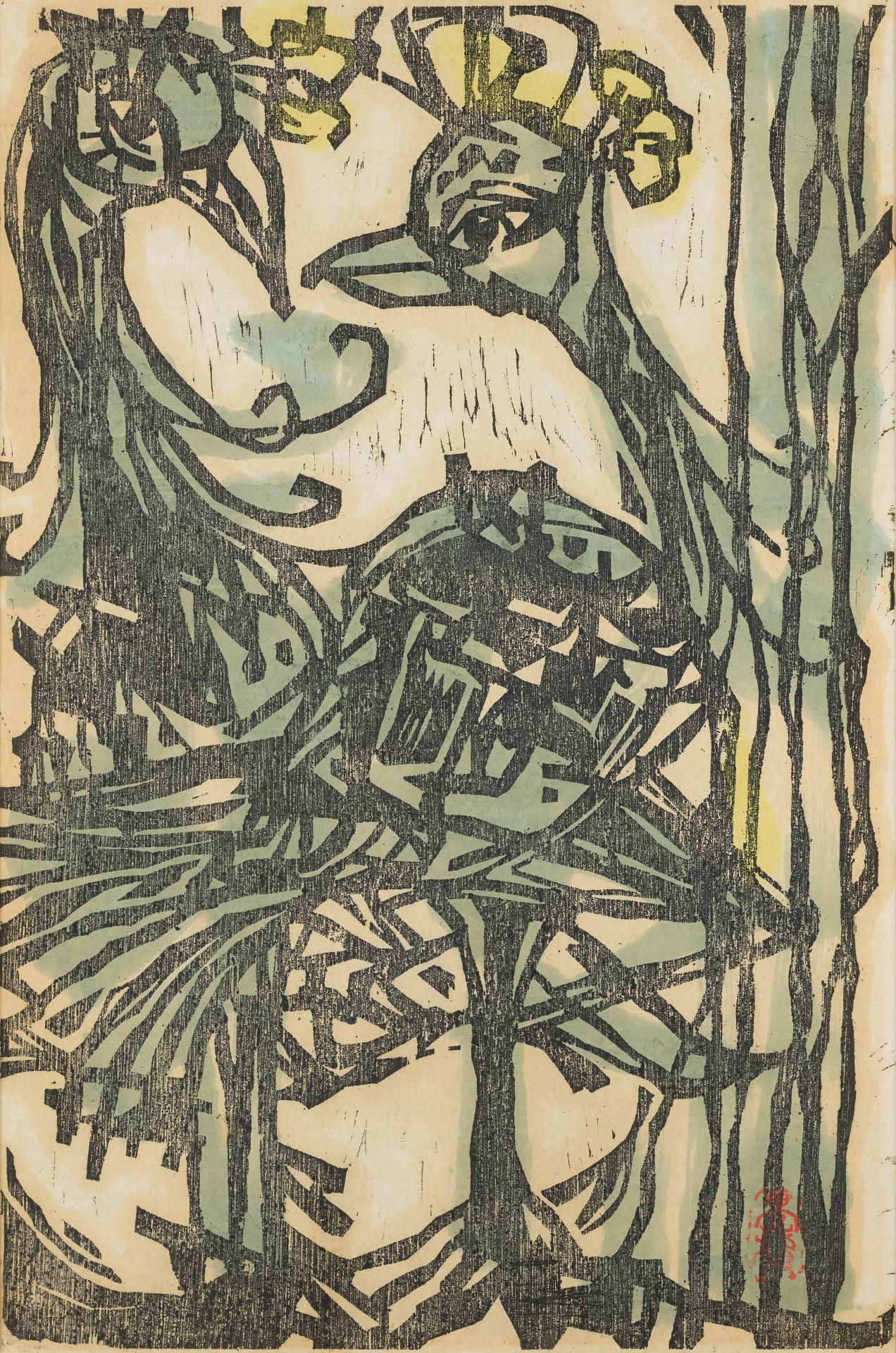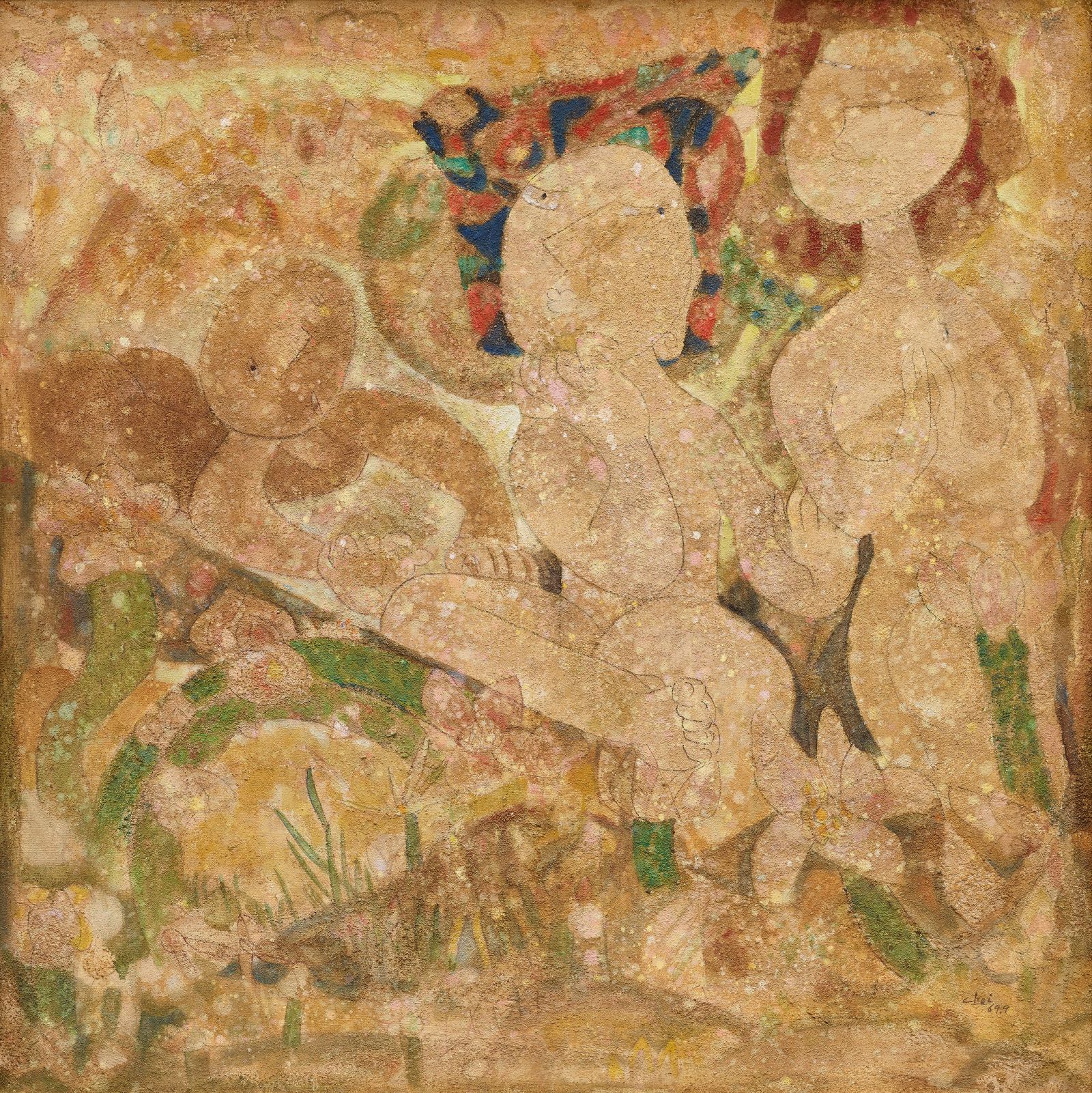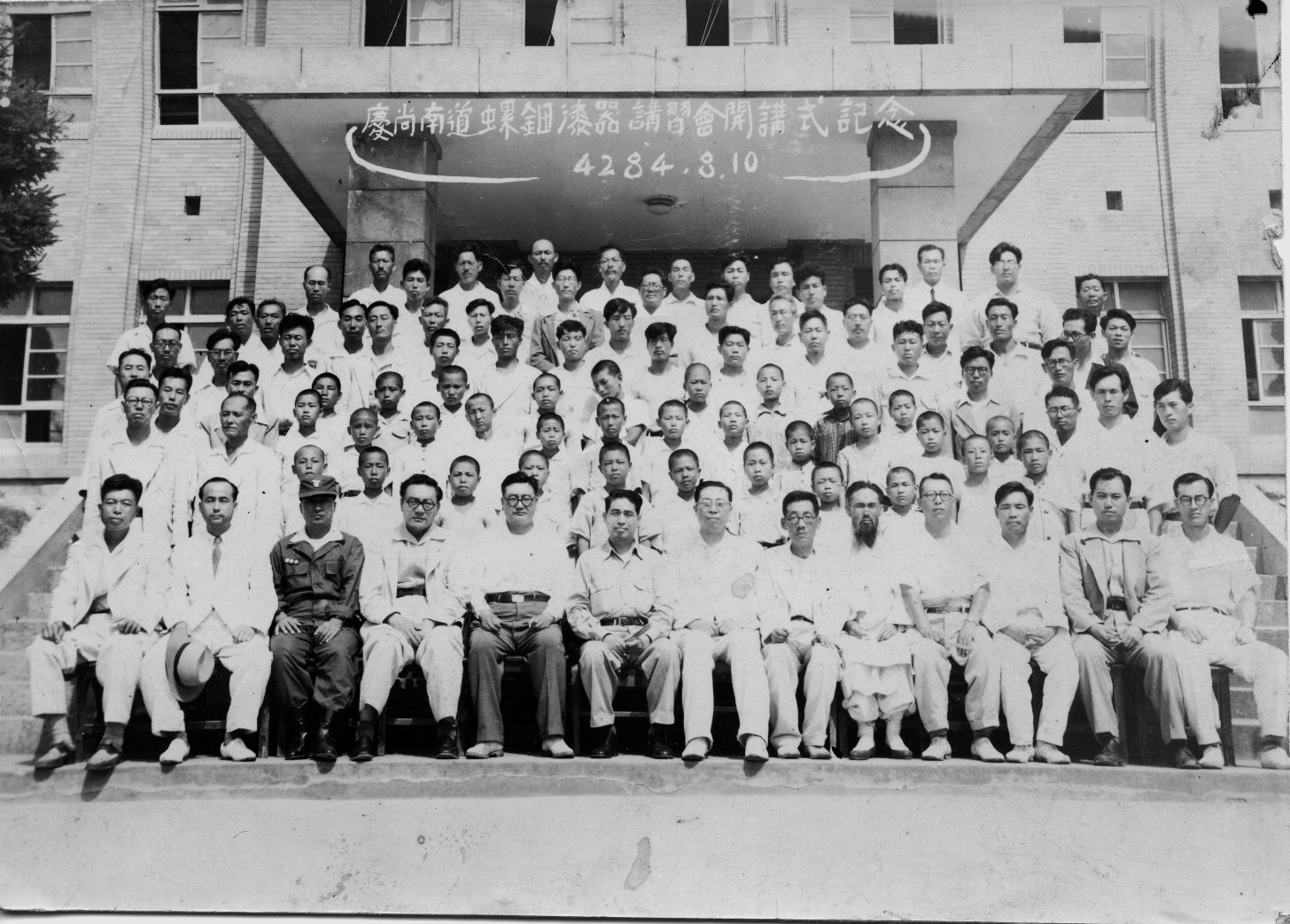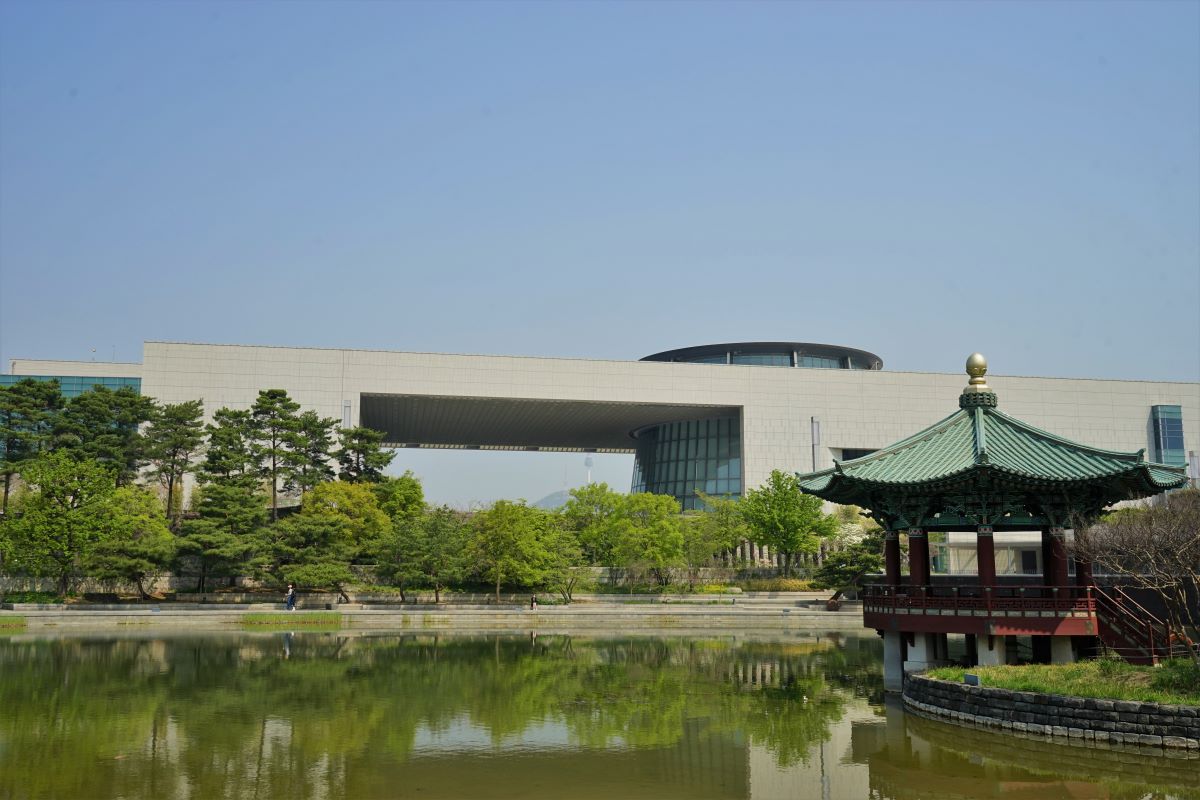
Yoo Kangyul, Birds-Of-Paradise, 1950s, Woodcut and color on paper, 60x40cm. MMCA collection
Yoo Kangyul
* Source: MMCA
Related
-

Korean Contemporary Printmakers Association
The Korean Contemporary Printmakers Association was founded in January 1968 to promote the distribution of and understanding about modern Korean prints while establishing a network between members. It was led by artists such as Kang Whansup, Kim Minja, Kim Sangyu, Kim Choungza, Kim Chonghak, Kim Foon, Bae Yoong, Suh Seungwon, Yoo Kangyul, Youn Myeungro, Rhee Sangwooc, Chun Sungwoo, and Choi Youngrim. It has played an important role in the revival of Korean prints, including holding regular association exhibitions, discovering and supporting artists, sharing knowledge on print through training sessions, and planning international exchange exhibitions. It has helped to produce leading artists in the Korean print field and organized joint exhibitions with various overseas artists to create a place for art exchanges. In 1996, the association announced regulations on original prints to provide an institutional system for the global internationalization of modern Korean print and the identification of Korean prints. Currently, more than 400 members are active.
-

Chung Kyu
Chung Kyu (1923-1971) was born in Goseong, Gangwon-do. He graduated from Gyeonggi Public Commercial School in 1941 and moved to Japan to attend the Department of Western Painting at Teikoku Art School. He returned to Korea in 1944 and stayed in Busan during the Korean War, moving to Seoul to be a researcher at the Korean Visual Art Research Institute from 1954 to 1962. He studied prints and ceramics in Rochester, New York, USA on a one-year invitation from the Rockefeller Foundation. After he came back, he expanded his art from painting to prints and ceramics. He was a founding member of the Korea Art Critics Association in 1956, the Korea Prints Association [Hanguk panhwa hyeophoe] in 1958, and the Korean Art Critics Association in 1960. He established the Institute of Korean Traditional Ceramics Craft in 1960. He contributed his prints to the Contemporary Art Exhibit sponsored by Chosun Ilbo and created ceramic murals at Oyang Building and Namsan Liberty Center, leaving an important mark on the development of public art in Korea. He worked as an art lecturer at Ewha Woman’s University from 1955 to 1961, at the department of craft, Hongik University from 1960 to 1963, and as a professor of the Department of Ceramics at Kyung Hee University from 1963 to 1971.
-

Choi Youngrim
Choi Youngrim (1916-1985) was the first son of a wealthy Oriental medicine pharmacist in Pyongyang. He joined a small art community at Gwangseong High School in Pyongyang and submitted a print to the Japanese Print Association. An oil painting of his was selected for the Joseon Art Exhibition [Joseon misul jeollamhoe] in 1935 and several more were selected through 1943. After independence, he participated in the National Art Exhibition (Gukjeon), the Creative Art Association Exhibition, and the Figurative Art Exhibition, and taught as an art professor at the College of Fine arts at Chung-Ang University. He simplified and reconfigured geometric objects using black outlines and flat planar forms in the 1950s. In the 1960s, he switched to color painting, with motifs from traditional folklore, such as Shimchung or The Story of a Tiger, and developed a painting technique of colourful painting by spreading oil on the canvas. He depicted primitive and innocent Utopian landscapes using the simple shades of ochre, and a soft smearing texture, often featuring round and voluptuous nude figures within.
Find More
-

Lacquerware Inlaid with Mother-of-Pearl Training Center
The Lacquerware Inlaid with Mother-of-pearl Training Center [Najeon chilgi gisulwon yangseongso] was established in August 1951 in Tongyeong city (then Tongyeong-eup), Gyeongsangnam-do Province under the name of Mother-of-Pearl Lacquerware Training School, a two-year provincial technical education institution with a capacity of forty students. In 1952, the following year, it was renamed under the current name to focus on fostering professional masters in mother-of-pearl inlaying and lacquering. There were 429 incoming students, and the institute graduated 82 students. Among the graduates from the center are Kim Seongsu, the director of the Ottchil Art Museum; Lee Hyungman, the holder of the National Important Intangible Cultural Heritage No. 10 (Mother-of-pearl inlaying); and Lee Munchan. In the early years of its establishment, the faculty consisted of Kim Bongryong (jureumjil technique of cutting mother-of-pearl pieces according to patterns and pasting them on the surface), Shim Bugil (kkeuneumjil technique of pasting mother-of-pearl pieces in thin and short strings), Yoo Kangyul (design), Ahn Yongho (lacquering), Jang Yunseong (drawing), and Kang Changwon (dry-lacquering). The painter Lee Jungseop, who stayed in Tongyeong to escape the Korean War, is said to have taught drawing to students at the center. In 1955, an advanced program, the Research Department, was established with the lacquering and mother-of-pearl inlaying divisions. In 1960, the basic curriculum was prolonged from two years to three years. As its jurisdiction institution was transferred from Gyeongsangnam-do Province to Chungmu-si (present-day Tongyeong-si) in August 1962, the training center was relocated to Jungang-dong (where Tongyeong Culture Center is currently located) and renamed the Chungmu Municipal Crafts Academy [Chungmu sirip gongye hagwon]. Since then, the training center had attempted various changes, such as the construction of a building with up-to-date facilities within the precinct of Nammangsan Park, with the aim of earning foreign currency through overseas exports. However, it was closed in 1971 when it stopped recruiting students due to financial difficulties and a shift in the direction of the export industry. The Lacquerware Inlaid with Mother-of-pearl Training Center, where professional education on mother-of-pearl inlaying and lacquering was conducted from early on after Korea’s independence, is considered as the birthplace of modern and contemporary craft education. Tongyeong is a hub of practicing mother-of-pearl inlaying and lacquering that carried on the legacy of the twelve workshops of the Regional Naval Headquarters during the Joseon dynasty. During the time when the training center existed, about half of the country’s craftspeople working in mother-of-pearl inlaying and lacquering lived in Tongyeong. The initial training center building in present-day Hangnam-dong, Tongyeong-si was designated as National Registered Cultural Heritage in December 2020.
-

National Museum of Korea
The National Museum of Korea is located at 137 Seobinggo-ro, Yongsan-gu, Seoul. The predecessor to the National Museum is the Yi Royal Family Museum founded in September 1908. The Yi Royal Family Museum showcased artwork owned by the royal family of Korea and was opened to the public in November 1909. The museum was relocated from its original home in the Japanese Government-General of Korea building to Gyeongbokgung Palace in 1910 and renamed the Japanese Government-General of Korea Museum in December 1915. The Japanese Government-General of Korea Museum collected and exhibited excavated artefacts and donated items from temples while conducting historical and archaeological research and archiving. The National Museum of Korea was established following the acquisition of the Japanese General-Government Museum in December 1945. In 1969, the National Museum of Korea merged with the Deoksugung Museum, the successor of the Yi Royal Family Museum. In October 2005, the National Museum of Korea moved to a newly constructed building at its current location in Seoul. As of December 31st, 2018, the museum holds a collection of approximately 410,000 pieces that span from the prehistoric to the modern era, and includes works from China, Japan, and Central Asia.






